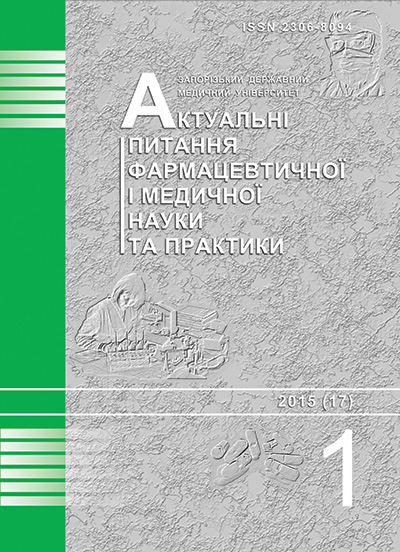The effect of combined antihypertensive therapy on left ventricular diastolic function in resting and postexercise patients with arterial hypertension
DOI:
https://doi.org/10.14739/2409-2932.2015.1.41647Keywords:
Hypertension, Diastolic Dysfunction, Perindopril, Losartan, AmlodipineAbstract
The correction of left ventricular diastolic function abnormalities hasn’t been well investigated in arterial hypertension.
The aim of the study was to determine the effects of two antihypertensive combinations (perindopril/amlodipine and losartan/amlodipine) on the state of diastolic function at rest and after exercise in patients with arterial hypertension.
Results. The early diastolic transmitral flow velocity and mitral annular tissue doppler velocities increased under fixed-dose combination of perindopril and amlodipine. The combination shortened the transmitral E-wave deceleration time and isovolumetric left ventricular relaxation time. The prevalence of diastolic dysfunction decreased from 55.8% to 31% on therapy with perindopril and amlodipine (p<0.05). The treatment reduced the frequency of pathologic results of diastolic exercise stress test. These changes were associated with improved exercise tolerance. Therapy with amlodipine and losartan shortened the deceleration time of early diastolic flow at rest and after exercise. The combination of amlodipine and losartan hasn’t reduced the prevalence of left ventricular diastolic dysfunction and hasn’t improved exercise tolerance.
Conclusions. The six-month treatment with fixed-dose combination of perindopril and amlodipine has a pronounced effect on improving ofLV diastolic function compared with a combination of losartan and amlodipine.
References
Kuznetsova T., Thijs L., Knez J., Herbots L., Zhang Z., & Staessen J. (2014). Prognostic value of left ventricular diastolic dysfunction in a general population. J Am Heart Assoc, 3(3), 1–11. doi: 10.1161/JAHA.114.000789.
Devereux, R., Wachtell, K., Gerdts, E., Boman, K., Nieminen, M., Papademetriou, V., et al. (2004). Prognostic significance or left ventricular mass change during treatment of hypertension. JAMA, 292(19), 2350–2356. doi:10.1001/jama.292.19.2350.
Wachtell, K., Okin, P., Olsen, M., Dahlöf, B., Devereux, R., Ibsen, H., et al. (2007). Regression of electrocardiographic left ventricular hypertrophy during antihypertensive therapy and reduction in sudden cardiac death: the LIFE study. Circulation, 116(7), 700–705. doi: 10.1161/CIRCULATIONAHA.106.666594.
Fagard, R., Celis, H., Thijs, L., & Wouters, S. (2009). Regression of left ventricular mass by antihypertensive treatment: a meta-analysis of randomized comparative studies. Hypertension, 54(5), 1084–1091. doi: 10.1161/HYPERTENSIONAHA.109.136655.
Tapp, R., Sharp, A., Stanton, A., O'Brien, E., Chaturvedi, N., Poulter, N., et al. (2010). Differential effects of antihypertensive treatment on left ventricular diastolic function: an ASCOT (Anglo-Scandinavian Cardiac Outcomes Trial) substudy. J Am Coll Cardiol, 55(17), 1875–1881. doi: 10.1016/j.jacc.2009.11.084.
Pitt, B., Pfeffer, M., Assmann, S., Boineau, R., Anand, I., Claggett, B., et al. (2014). Spironolactone for heart failure with preserved ejection fraction. NEJM; 370(15), 1383–1392. doi: 10.1056/NEJMoa1313731.
Edelmann, F., Wachter, R., Schmidt, A., Kraigher-Krainer, E., Colantonio, C., Kamke W., et al. (2013). Effect of spironolactone on diastolic function and exercise capacity in patients with heart failure with preserved ejection fraction: the Aldo-DHF randomized controlled trial. JAMA, 309(8), 781–791. doi: 10.1001/jama.2013.905.
Liakos, C., Michaelides, A., Vyssoulis, G., Chatzistamatiou, E., Dilaveris, P., Markou, M., et al. (2012). The antihypertensive treatment effect on left ventricular diastolic function is reflected in exercise electrocardiogram. J Electrocardiol, 45(1), 28–35. doi: 10.1016/j.jelectrocard.2011.07.014.
Nagueh, S., Appleton, C., Gillebert, T., Marino, P., Oh, J., Smiseth, O., et al. (2009). Recommendations for the evaluation of left ventricular diastolic function by echocardiography. J Am Soc Echocardiogr, 22(2), 107–133. doi: 10.1016/j.echo.2008.11.023.
Burgess, M., Jenkins, C., Sharman, J., Marwick, T. (2006). Diastolic stress echocardiography: hemodynamic validation and clinical significance of estimation of ventricular filling pressure with exercise. J Am Coll Cardiol, 47(9), 1891–1900. doi:10.1016/j.jacc.2006.02.042.
Dahlöf, B., Sever, P., Poulter, N., Wedel, H., Beevers, D., Caulfield, M., et al. (2005). Prevention of cardiovascular events with an antihypertensive regimen of amlodipine adding perindopril as required versus atenolol adding bendroflumethiazide as required, in the Anglo-Scandinavian Cardiac Outcomes Trial-Blood Pressure Lowering Arm (ASCOT-BPLA): a multicentre randomised controlled trial. Lancet, 366(9489), 895–906. doi: http://dx.doi.org/10.1016/S0140-6736(05)67185-1.
Sharp, A., Tapp, R., Thom, S., Francis, D., Hughes, A., Stanton, A., et al. (2010). Tissue doppler E/E′ ratio is a powerful predictor of primary cardiac events in a hypertensive population: an ASCOT substudy. Eur Heart J, 31(6), 747–752. doi: 10.1093/eurheartj/ehp498.
Barron, A., Hughes, A., Sharp, A., Baksi, A., Surendran, P., Jabbour, R., et al. (2014). Long-term antihypertensive treatment fails to improve E/e′ despite regression of left ventricular mass. An Anglo-Scandinavian Cardiac Outcomes Trial Substudy. Hypertension, 63(2), 252–258. doi: 10.1161/HYPERTENSIONAHA.113.01360.
Holland, D., Prasad, S., & Marwick, T. (2010). Prognostic implications of left ventricular filling pressure with exercise. Circ Cardiovasc Imaging, 3(2), 149–156. doi: 10.1161/CIRCIMAGING.109.908152.
Kolesnyk, M. Yu. (2014). Vyiavlennia oznak pidvyshchennia tysku napovnennia livoho shlunochka za dopomohoiu stres-ekhokardiohrafii z dozovanym fizychnym navantazhenniam u cholovikiv z neuskladnenoiu arterialnoiu hipertenziieiu [Estimation of increased left ventricular filling pressure with exercise stress echocardiography in men with uncomplicated arterial hypertension]. Sertse i sudyny, 3, 44–52. [in Ukrainian].
Yamamoto, K., Ozaki, H., Takayasu, K., Akehi, N., Fukui, S., Sakai, A., et al. (2011). The effect of losartan and amlodipine on left ventricular diastolic function and atherosclerosis in Japanese patients with mild-to-moderate hypertension (J-ELAN) study. Hypertens Res, 34(3), 325–330. doi: 10.1038/hr.2010.237.
Müller-Brunotte, R., Kahan, T., Malmqvist, K., Ring, M., & Edner, M. (2006). Tissue velocity echocardiography shows early improvement in diastolic function with irbesartan and atenolol therapy in patients with hypertensive left ventricular hypertrophy. Results form the Swedish Irbesartan Left Ventricular Hypertrophy Investigation vs Atenolol (SILVHIA). Am J Hypertens, 19(9), 927–936. doi: 10.1016/j.amjhyper.2006.02.009.
Solomon, S., Janardhanan, R., Verma, A., Bourgoun, M., Daley, W., Purkayastha, D., et al. (2007). Effect of angiotensin receptor blockade and antihypertensive drugs on diastolic function in patients with hypertension and diastolic dysfunction: a randomised trial. Lancet, 369(9579), 2079–2087. doi: http://dx.doi.org/10.1016/S0140-6736(07)60980-5.
Downloads
How to Cite
Issue
Section
License
Authors who publish with this journal retain copyright and grant the journal right of first publication with the work simultaneously licensed under a Creative Commons Attribution License that allows others to share the work with an acknowledgement of the work's authorship and initial publication in this journal.


